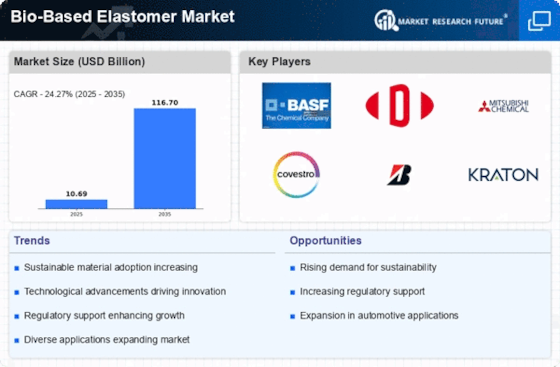Supportive Regulatory Frameworks
The establishment of supportive regulatory frameworks is crucial for the growth of the Bio-Based Elastomer Market. Governments worldwide are increasingly implementing policies that promote the use of renewable materials and sustainable practices. For example, regulations that incentivize the use of bio-based products in manufacturing processes may lead to a surge in demand for bio-based elastomers. Furthermore, compliance with environmental standards and certifications can enhance market access for manufacturers, thereby fostering competition and innovation. As regulatory bodies continue to prioritize sustainability, the bio-based elastomer sector is likely to benefit from increased funding and research initiatives aimed at developing advanced bio-based materials. This supportive environment may catalyze the growth of the bio-based elastomer market, encouraging more companies to transition towards sustainable practices.
Rising Demand for Sustainable Materials
The increasing consumer awareness regarding environmental issues appears to drive the demand for sustainable materials, including bio-based elastomers. As industries seek to reduce their carbon footprint, the Bio-Based Elastomer Market is witnessing a notable shift towards eco-friendly alternatives. Reports indicate that the market for bio-based materials is projected to grow at a compound annual growth rate of approximately 10% over the next few years. This trend suggests that manufacturers are likely to invest in bio-based elastomers to meet consumer preferences and regulatory requirements, thereby enhancing their market position. Furthermore, the growing emphasis on circular economy principles may further bolster the adoption of bio-based elastomers, as companies strive to create products that are not only sustainable but also recyclable.
Technological Innovations in Production
Technological advancements in the production of bio-based elastomers are likely to play a pivotal role in the Bio-Based Elastomer Market. Innovations such as improved polymerization techniques and the development of new bio-based feedstocks could enhance the efficiency and cost-effectiveness of bio-based elastomer production. For instance, recent studies suggest that the integration of biotechnological processes may reduce production costs by up to 20%, making bio-based elastomers more competitive against traditional petroleum-based alternatives. Additionally, advancements in material properties, such as enhanced durability and flexibility, may expand the application range of bio-based elastomers in various sectors, including automotive and consumer goods. This technological evolution indicates a promising future for the bio-based elastomer sector, as it aligns with the growing demand for high-performance, sustainable materials.
Expanding Applications Across Industries
The versatility of bio-based elastomers is driving their adoption across various industries, which is a key driver for the Bio-Based Elastomer Market. These materials are increasingly utilized in sectors such as automotive, construction, and consumer goods due to their favorable properties, including flexibility, durability, and resistance to environmental factors. For instance, the automotive industry is projected to witness a significant increase in the use of bio-based elastomers for components such as seals and gaskets, driven by the need for lightweight and sustainable materials. Additionally, the construction sector is exploring bio-based elastomers for applications in insulation and sealants, further broadening their market reach. This expanding application spectrum suggests that the bio-based elastomer market may experience robust growth as industries seek to incorporate sustainable materials into their product offerings.
Consumer Preference for Eco-Friendly Products
The growing consumer preference for eco-friendly products is a significant driver for the Bio-Based Elastomer Market. As awareness of environmental issues rises, consumers are increasingly seeking products that align with their values, prompting manufacturers to adopt sustainable practices. This shift in consumer behavior is reflected in market trends, where products made from bio-based materials are gaining traction. Reports indicate that approximately 60% of consumers are willing to pay a premium for sustainable products, which could incentivize companies to invest in bio-based elastomers. Furthermore, brands that prioritize sustainability may enhance their reputation and customer loyalty, leading to increased market share. This consumer-driven demand for eco-friendly alternatives is likely to propel the growth of the bio-based elastomer market, as companies strive to meet evolving consumer expectations.



















Leave a Comment